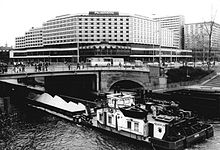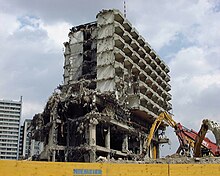Palasthotel (Berlin)

The palace hotel was opened in 1979 in Berlin-Mitte on the Spree and operated by the Interhotel chain until 1992 . After it was closed, the complex was demolished in 2001, and the DomAquarée CityQuartier was built on its site and houses a Radisson Blu chain hotel .
location

The GDR palace hotel was located on a plot of land on the Spree that was bordered by Karl-Liebknecht-Strasse and Spandauer Strasse . On the other side of the river was the Berlin Cathedral and the Palace of the Republic, which has now also been demolished . The Marx-Engels-Forum was on the other side of Karl-Liebknecht-Strasse.
The Palast Hotel on Potsdamer Platz
Before the palace hotel on the Spree, there was already a hotel with this name on Potsdamer Platz . The house, built by Ludwig Heim between 1892 and 1893, was located north between Potsdamer Platz and Leipziger Platz, opposite the Hotel Fürstenhof .
From 1936 the building was used by the Central European Travel Agency. During the construction of the Potsdamer Platz S-Bahn station of the north-south S-Bahn , which opened in 1939 , the western wing of the building was completely supported by an elaborate supporting structure in order to be able to erect the S-Bahn platform below it for the north direction. The massive pillars in the middle of the platform can still be seen on this platform, which were initially used as illuminated showcases. The building burned down in a bombing raid in 1943, and the ruins were cleared away in the post-war period.
history
Planning for the new hotel began in 1976. Before the Second World War, there were residential buildings on the site , some of which were badly damaged and demolished around 1950. According to a design by Ferenc Kiss , construction work began under the direction of Erhardt Gißke . The three-winged building, which spanned an inner courtyard, was divided vertically into three areas. The lower two, sometimes three floors were a horizontally oriented low-rise building in which restaurants , bars and a café - with a total of 2000 seats - were located. Connected via a technical mezzanine, a building with 600 hotel rooms and 40 suites with a total of 1000 hotel beds was enthroned. The main entrance with the driveway was in the inner courtyard, through which the underground car park could also be reached.
The hotel was one of four hotels in the GDR that could not be used by GDR citizens and were aimed exclusively at a western audience. In return, it was equipped with “Western products” that were otherwise hardly or not available in the GDR, such as the sedans from BMW, Audi and Volvo. It served as a contact point for the GDR foreign exchange procurer Alexander Schalck-Golodkowski and the Ministry for State Security (MfS). Schalck-Golodkowski had an office in rooms 80.26 and 80.27 under the direction of the Austrian Herbert Rübler. The Rübler, responsible for purchasing western products, died in 1989 of a head injury in the palace hotel.
The MfS monitored large parts of the hotel by video and had 25 to 30 of the rooms equipped with hidden audio and video recording devices. Guests who are interested in the service were allocated these rooms. Among other things, the MfS used prostitutes to skim off information from Western guests. The MfS brought the terrorist Abu Daoud , who masterminded the hostage situation in Munich in 1972, to the hotel for a long time from 1981.
After German reunification, the hotel was continued by Interhotel AG until 1992. The first state representation of North Rhine-Westphalia in Berlin moved into a wing. The Radisson SAS chain took over the house in 1992. In 1995 it was comprehensively renovated again for 60 million DM.
The hotel was closed on December 1, 2000, and demolition began on January 15, 2001. During the demolition work on June 20, 2001, an American 250-kilogram aerial bomb was found at a depth of four meters . Since 1979 the concrete foundation of the hotel had been above the dud , which had been lying in the ground unnoticed for 55 years. The bomb was defused on site.
The hotel plays a central role in Thomas Brussig's 2004 novel How it Glows . Matthias Matussek was a correspondent in the palace hotel. He published his memories and descriptions of German unity in the books Palasthotel or How Unity fell over Germany and Palasthotel Zimmer 6101. Reporter in the maddening Germany .
gastronomy
The gastronomic areas of the palace hotel could also be used by GDR citizens. The hotel housed the large café at the palace , as well as several restaurants and bars. In the side wing, on the first floor facing the Berlin Cathedral, there was also a ballroom that could be functionally separated into several rooms. There were a total of 8 kitchens for the restaurants mentioned. The “Jade” restaurant shared a kitchen with the French restaurant “Rôti d òr”. A kitchen was also responsible for the “Cafe am Palast” and the “Domklause”. In the basement there was the main kitchen as well as shock freezers, cold stores and preparation rooms.
- Rôti d'or , restaurant with French cuisine
- Märkisches Restaurant , dining restaurant (176 seats)
- Jade , Asian restaurant
- Quick , self-service restaurant (120 seats)
- Domklause , restaurant for hearty meals, with an additional terrace facing the Spree
- Cafe am Palast including terrace (view of Spree, Berlin Cathedral and Palace of the Republic)
- Nante-Eck , beer bar (75 seats)
- grill
- Skybar
- Sinus-Bar , exclusive night bar
- Piano bar
- Fireplace bar
Web links
Individual evidence
- ^ Palace Hotel on Potsdamer Platz
- ↑ Berlin. Architecture from Pankow to Köpenick . VEB Verlag für Bauwesen, Berlin 1987
- ↑ Dirk Banske, Michael Behrendt: Death from the East . In: Die Welt , September 26, 2003
- ↑ Billions with KoKo . In: SPIEGEL special 2/1990, page 58
- ↑ Love opens every safe . In: Der Spiegel . No. 9 , 1991, pp. 84-94 ( online ).
- ↑ F. Kunke, D. Reichert: Gentle cancellation in Berlin-Mitte ( page can no longer be accessed , search in web archives ) Info: The link was automatically marked as defective. Please check the link according to the instructions and then remove this notice. (PDF; 1.1 MB) In: Tiefbau 2/2002
- ↑ 250 kilo bomb was on the cathedral for 55 years. Where the palace hotel last stood. BZ Online from June 21, 2001
Coordinates: 52 ° 31 '10.8 " N , 13 ° 24' 9.6" E

